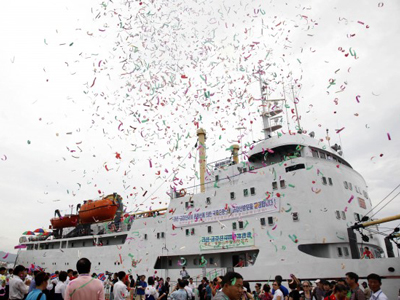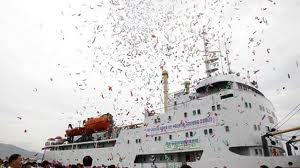“No man will be a sailor who has contrivance enough to get himself into a jail; for being in a ship is being in a jail, with the chance of being drowned… a man in a jail has more room, better food, and commonly better company. “
Samuel Johnson

More than a few eyes in the cruise industry industry are now focused on the development of new business in Asia and the Pacific Basin… Costa was the first line to recognize that potential, placing a ship in China in 2006.They’ve invested more than 50 million Euros in the Asia market and they will exceed 100 calls in Chinese ports this year.
Royal Caribbean has seen huge growth in the China market since placing the Legend of the Seas there in 2008. Think about it, 75% of their passengers boarding in Tianjin and Shanghai are Chinese. What an extraordinary opportunity for Americans to go on a vacation where they can actually get up close and personal with Chinese citizens. I may require my clients to do a cruise like that before I agree to send them anywhere else.
Look at it from the cruise line’s perspective. The Asia Pacific Region has more than 3.5 billion potential cruisers. So cruise lines are in a mad rush to set up China-based sales offices and to find the best way to say “It’s different out Here” in Mandarin.
But you see, that is the problem. All of the most intelligent eyes in the cruise industry are focused on the potential of cruising in China. But no one is paying attention to the growth of a new cruise line in Asia that threatens to put them all out of business.
It turns out, you see, that North Korea is entering the cruise business. Now some might not take this seriously, since North Korea’s capital, Pyongyang, is home to the Ryugyong Hotel, described by Esquire Magazine as “The Worst Building in the History of Mankind.” I took that remark to mean that the author didn’t care for the architecture. We’ll get to North Korea’s cruise ship in a moment but the good news is that it was not designed by the same team that built the one hundred and five story hotel, a property so hideous and unsafe that it has not had a single guest for two decades. You may be able to Google this 3,000 room hotel if you are lucky enough to find an unofficial photo of the Capital in which the hotel has not been airbrushed out. North Korea takes its investments in tourism seriously and the government poured 2% of its entire gross domestic product into the so-called Hotel of Doom.
So with this background, what could we expect from a new North Korean cruise line?
In early November, 500 Chinese tourists, travel agents and North Korean tourism executives boarded the “cruise ship” Mangyongbong in the North Korean port of Rason for a leisurely cruise down the east coast of the country, disembarking in Kumgang. It isn’t hard to board this new cruise line. You simply work with the proper travel agency in China, get yourself to the Chinese city of Yanji, and then do a three-hour drive to the port. But bring a cushion; the roads are filled with large holes and small craters.
The Mount Kumgany Region, the highlight of the itinerary, is actually quite beautiful and it was a resort area that was to be co-developed by South and North Korea, accepting tourists from both countries. Unfortunately, this tourism harmony sort of fell apart when North Korean guards started shooting South Korean tourists.
Now, North Korea has a new partner in the Chinese and they are working to build up a cruise industry while encouraging outside investment. The Vice Mayor of Rason mentioned in an interview that people from Jamaica don’t need a tourist visa. But they can’t bring their mobile phones. Why would North Korean officials believe that tourists from Jamaica would want to sail out of North Korea on a short cruise? It must be the ship.
The invited press, including a travel writer for the New York Times, observed that the Mangyongbong was a forty-nine year old refurbished cargo ship with rusty portholes and musty cabins. The send-off was memorable as 500 locals dressed in workers clothing waved to people in officers clothing while carnival music blared form two minivans parked on the pot-hole filled pier.
Then fireworks went off, flags were raised, and collections of plastic flowers were tossed onto the open deck.
Cabin categories were rather straightforward. Many guests were asked to sleep on wooden bunk beds but those in lower cost categories were assigned mattresses on the floor. The normal arrangement was eight to a room. Meals were served cafeteria style on metal trays.
As the ship sailed, fresh coffee was served. The entertainment director arranged for Karaoke and decks of playing cards. A fair number of the bathrooms lacked water. The food, described by the NY Times as “resembling a mess hall at an American Army Base” was mostly uneaten. Leftovers were dumped overboard but because of capricious winds much of the food made it back to the ship.
Now I could stop here and we could all dismiss this new cruise product. But I’ve read some of the interviews with the Chinese travel agents on this inaugural. And several of them felt that, at about $440 USD for a five-night cruise, it would be a relatively easy sell. It would appeal to Chinese who do not live along the coast as well as the large ethnic Korean population along the Chinese border. Chinese tourism to North Korea is already a reality. And guess what? The Tourism ministry spokesman alluded to a “much newer” 900 passenger ship to be added to the fleet. But they are looking for a little “investment” money.
No announcement has yet been made about possible pre or post cruise hotel stays using the Ryugyong’s available rooms.
This important inaugural cruise ended with a bit of appropriate theatrics as the Mangyongbong crashed into the pier while docking, turning portions of the pier into rubble.

